Consider Your Senses in a New COVID-19 Library Environment
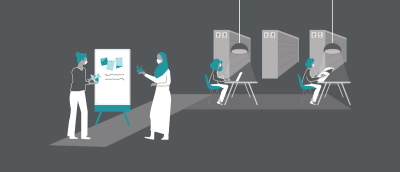
by Traci Engel Lesneski, CID, IIDA, LEED AP, Associate AIA, CEO and Principal, MSR Design
As the world works toward establishing a new normal, attention is turning to the next normal in the built environment. Over 90% of the day in the best of times is spent in the built environment. For libraries, ensuring healthy public, private and staff spaces in both the short- and long-term is vital.
Today’s libraries are central community hubs that offer a wide range of resources and services to foster learning, curiosity and discovery in all the literacies required to thrive. Many discussions about library design center around human interaction and high-touch experiences such as increased space for community gathering and hands-on learning.
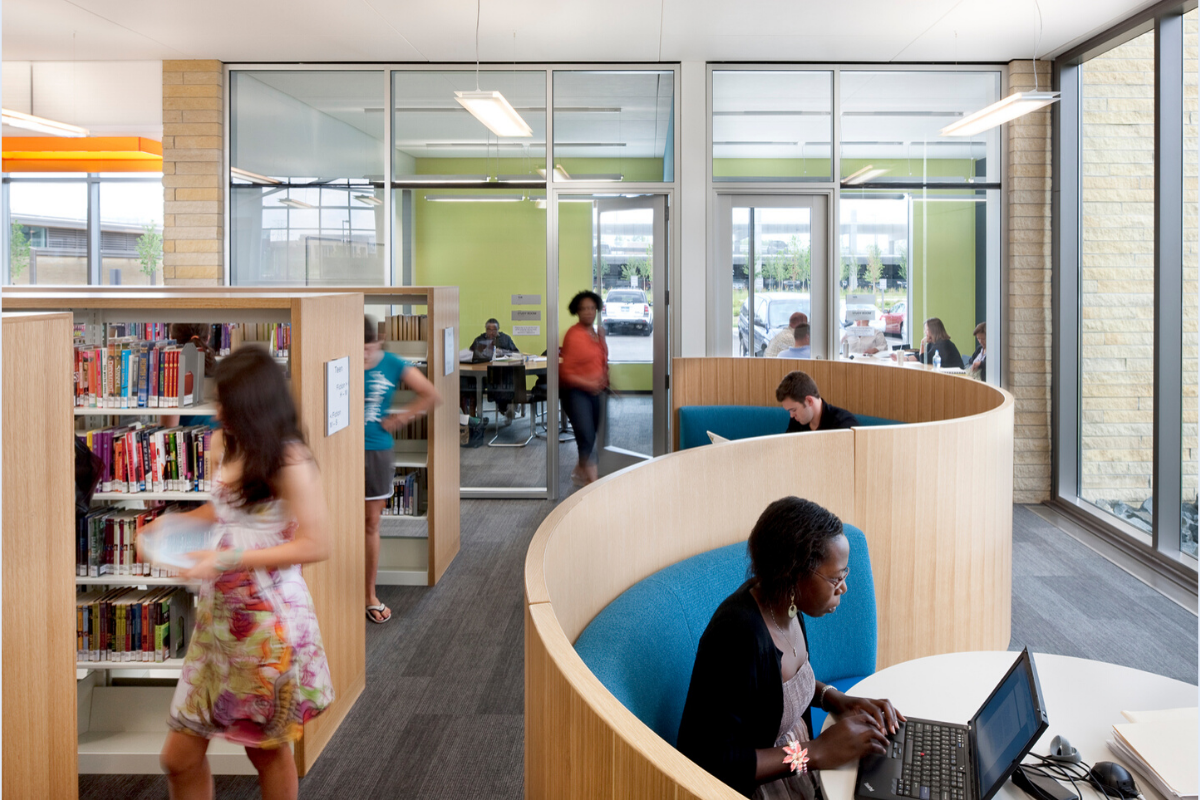
Maple Grove Library, Hennepin County
Photo by: Lara Swimmer
Like all built environments, library buildings engage the five primary senses of touch, sight, smell, hearing and even taste (through breathing the air) for visitors. Each of these engagements with library buildings is impacted by COVID-19.
The risks associated with gathering in public places while the pandemic is still ongoing are real. As libraries plan to reopen, an opportunity lies in supporting health and well-being while allaying fears associated with returning to buildings. Considering our senses and how we interact with one another offers a helpful way to organize the many issues and options.
What We Touch
Public health experts and medical professionals have advised everyone to wash our hands frequently, maintain physical distance and avoid touching our faces and material objects. Yet libraries are by nature high-touch environments with shared resources, which presents challenges for the design of safe use. Library users and staff may be understandably concerned about using shared tables and chairs. The best protection for shared surfaces is to clean and disinfect high-touch surfaces regularly and remind people to wash their hands frequently and properly.
Additional impactful actions are replacing soap dispensers and faucets with touchless versions, distributing touchless trash and recycling receptacles throughout the building and removing doors from cabinets.
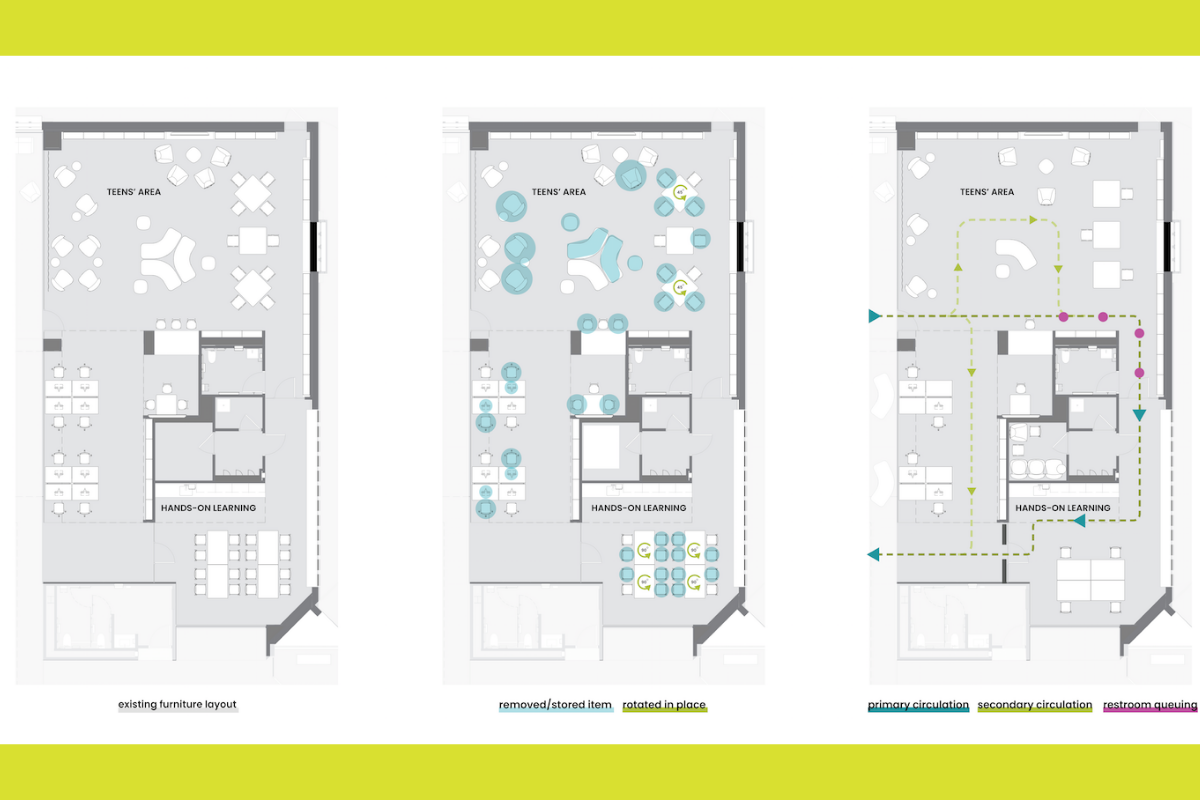
Floor plan sequence for physical distancing at Eden Prairie Library, Hennepin County
Frequent cleaning of shared surfaces such as tables and seating is critical. Making cleaning visible reassures building users. For large libraries, placing placards stating that a seat or table was recently used and awaits cleaning may help manage time spent cleaning. Over time, entry doors can be replaced with touchless versions and soft upholstery replaced with wipeable textiles (but avoid anti-microbial products, which are harmful to humans and ineffective against the virus).
What We See
Visually chaotic surroundings intimidate many library users, and during a pandemic may create a perception of germ-harboring. Keep materials tidy, and limit display of materials to fixtures. Avoid cluttering the tops of shelving to facilitate cleaning and reduce surfaces for virus to land on. A perception of cleanliness is important as well; choosing building materials that look clean when they are clean will be especially key at this time.
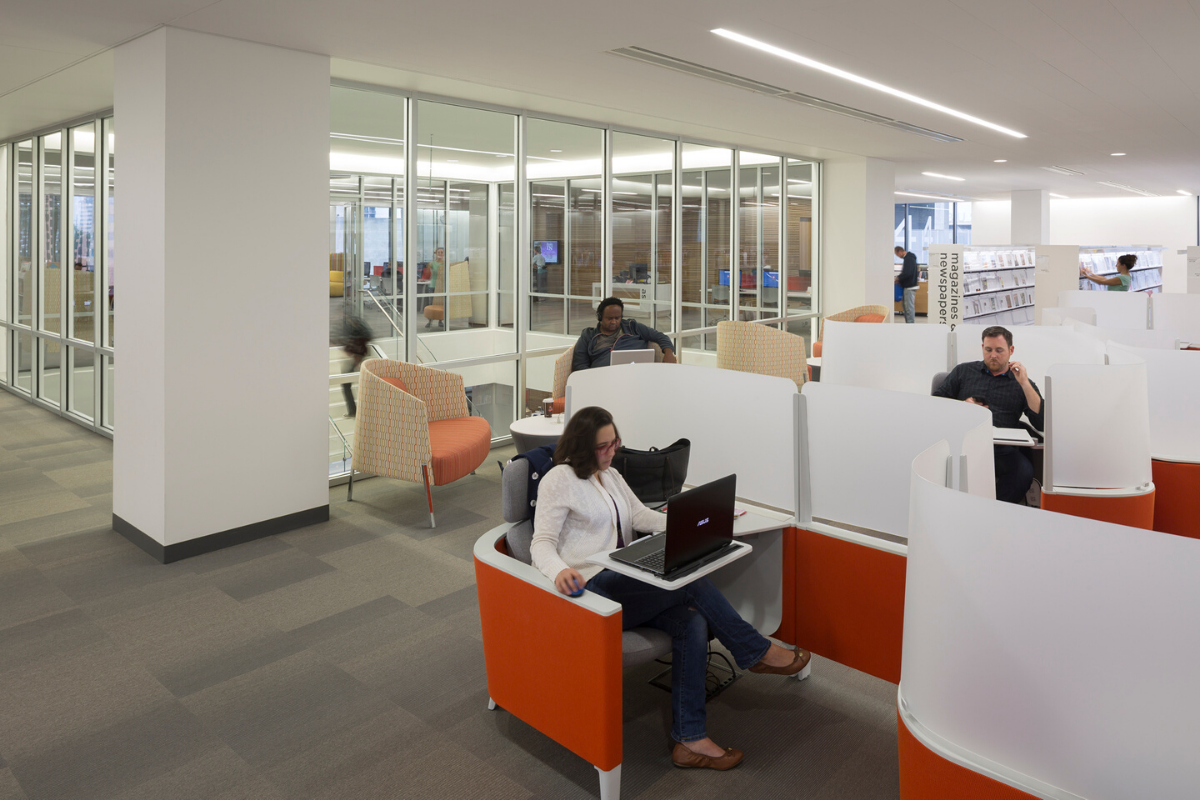
Tulsa City-County Library — Central Library
Photo by: Lara Swimmer
People will need visual cues to ingrain the behavioral changes required for physical distancing. Mark seating zones, and queuing at check-outs and toilet rooms with floor markers. Movable privacy screens, markerboards, panels, drapery, storage units, plants and other items can be used break down large spaces into safe increments. Arrows on the floor to show traffic direction in narrow aisles will serve as reminders.
Access to nature has proven benefits, such as increased mental focus and health, improved creativity and stress reduction. Position seating near windows with views to the outdoors or place live plants throughout the building. Libraries with outdoor space can offer physically-distanced programming. Community gardens in raised garden beds can be temporarily installed in areas without green space (e.g., in underutilized parking lots).
What We Breathe
Public health experts have underscored that COVID-19 is mostly spread by respiratory droplets released when people breathe, talk, cough, sneeze and sing. Being with people from other households in interior spaces is a risk, but this risk can be reduced by breaking the transmission pathways of aerosolized viruses. To increase the health of indoor air, introduce more outside air, reduce the mixing of air in occupied spaces and optimize the relative humidity to stay within a range of 40 to 60 percent.
What We Hear
Even the healthy occasionally cough or sneeze, and these sounds can cause anxiety to many customers and staff. Spacing furnishings to allow physical distancing is necessary and will provide a measure of comfort and safety. Privacy dividers around study and lounge seating, or the use of movable fixtures such as markerboards, can offer privacy, separation and protection from direct contact with others (and their coughs).
The removal of soft furniture for distancing and bias for cleanable surfaces may produce adverse effects on acoustics. White noise can help mask some noises. Add sound absorptive surfaces in trouble zones.
Further Reading
This blog post was adapted from the full-length article, “Sensory Library Design: Responding to a Pandemic’s Impact on Built Environments” by the same author. For access to the full text, please contact Traci Lesneski at traci@msrdesign.com or see an online version here.
CEO and principal of MSR Design, Traci Engel Lesneski focuses on design for libraries and learning. She promotes an integrated design approach — equally valuing human well-being, building performance, aesthetics, and delight. Recent building projects Traci has led include the award-winning VCAM building — a 24/7 visual culture, arts, and media creative hub for Haverford College in Pennsylvania — and Missoula’s new library and culture house (opening in summer 2020 in Montana). Traci regularly contributes articles to library publications and lectures nationally and internationally about the built environment’s role in fostering well-being, promoting learning, and creating inclusive and cohesive communities. Traci is chair of the American Library Association’s Architecture for Public Libraries Committee and a member of IFLA’s Library Buildings and Equipment Section Standing Committee.
August 11 Webinar: How Pandemics Impact Library Buildings and Technology
Learn more about this topic during a free webinar hosted by bibliotheca on August 11 — How Pandemics Impact Library Buildings and Technology. To register for the webinar, please visit the bibliotheca website.
Related Articles

Reimagining Library Spaces to Provide Essential Community Services
Urban Libraries Council
Learn how ULC libraries across North America are transforming their physical spaces to support community relief and recovery efforts during the COVID-19 pandemic.
Learn More
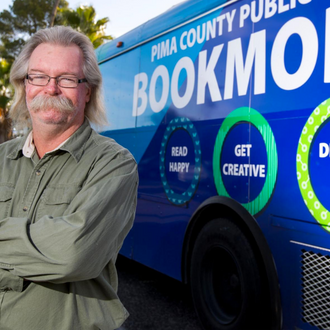
A Testament to the Caring Community We Call Home
Pima County Public Library
Learn how Pima County Public Library staff jumped at the opportunity to provide much-needed support to other county departments after temporarily closing their doors due to the coronavirus outbreak.
